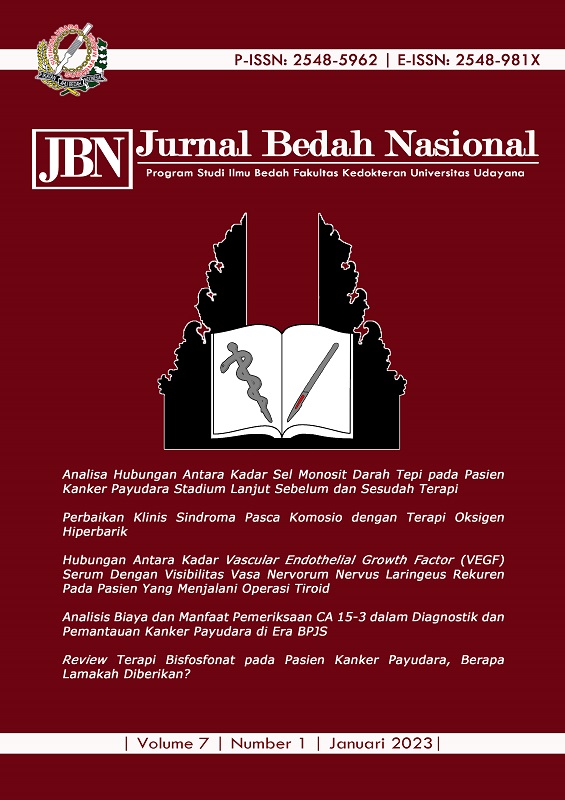Perbaikan Klinis Sindroma Pasca Komosio dengan Terapi Oksigen Hiperbarik
Abstract
Tujuan: Tujuan penelitian ini untuk membuktikan bahwa terapi oksigen hiperbarik (TOHB) mempercepat proses penyembuhan kumpulan gejala pasien cedera kepala ringan (CKR). Metode: Penelitian ini didapatkan sebanyak 20 pasien CKR dan diikutsertakan dalam penelitian. Penelitian ini menggunakan rancangan controlled trial yang membandingkan kondisi outcome 2 kelompok perlakuan, yakni pasien CKR dengan TOHB vs. kontrol. Kelompok kontrol akan menerima terapi standar CKR menurut protokol Advanced Trauma Life Support (ATLS). Setelah penanganan sesuai protokol ATLS, kelompok TOHB akan mendapatkan juga sesi TOHB, yaitu oksigen bertekanan 2-3 atmosphere absolute (ATA) dengan 100% oksigen dalam ruang udara bertekanan tinggi, selama 60 menit. Hasil: Skor Rivermead Post-Concussion Symptoms Questionnaire (RPQ), baik ketiga item awal (RPQ-3) yang berhubungan dengan gejala awal cedera kepala maupun ketiga belas item berikutnya (RPQ-13) yang memuat gejala lanjut cedera kepala, tidak berbeda pada kedua kelompok penelitian sebelum pengobatan dilakukan. Namun diakhir minggu kelima pasca terapi pasien-pasien dengan TOHB memperlihatkan skor RPQ jauh lebih baik (rerata 3,1 vs. 6,5 pada RPQ-3, dan 14,2 vs. 29,6 pada RPQ-13. Hasil penelitian ini membuktikan bahwa TOHB terhadap pasien CKR terjadi penurunan skor RPQ, baik RPQ-3 dan RPQ-13 yang bermakna (p<0,001). Simpulan: Penelitian ini telah membuktikan pengaruh TOHB mempercepat proses penyembuhan kumpulan gejala pasien CKR (sindroma pasca komosio).
Downloads
References
2. Prasetyo E, Islam AA, Hatta M, dkk. The Profile of MMP-9, MMP-9 mRNA Expression, -1562 C/T Polymorphism and Outcome in High-risk Traumatic Brain Injury: The Effect of Therapeutic Mild Hypothermia. Neurol Med Chir (Tokyo). 2017;57:612-9.
3. Sepahvand E, Jalali R, Mirzaei M, dkk. Glasgow coma scale versus full outline of unresponsiveness scale for prediction of outcomes in patients with traumatic brain injury in intensive care unit. Turk Neurosurg. 2016;26:720-4.
4. Satyanegara, Arifin MZ, Hasan RY, dkk. Ilmu Bedah Saraf Satyanegara. Edisi ke-5. Jakarta: PT Gramedia; 2014.
5. Hatibie MJ, Islam AA, Hatta M, dkk. Hyperbaric Oxygen Therapy for Second-Degree Burn Healing: An Experimental Study in Rabbits. Adv Skin Wound Care. 2019;32:1-4.
6. Buck DW, Galiano RD. Wound care. Dalam: Thorne CH, Chung KC, Gosain AK, dkk, editor. Grabb & Smith’s Plastic Surgery. Edisi ke-7. Philadelphia: Lippincott Williams & Wilkins; 2014. h. 20-8.
7. Wibowo A. Oksigen Hiperbarik: Terapi Percepatan Penyembuhan Luka. JuKe Unila. 2015;5:124-8.
8. Sánchez EC. Mechanisms of Action of Hyperbaric Oxygenation in Stroke: A Review. Crit Care Nurs Q. 2013;36:290-8.
9. Braswell C, Crowe DT. Hyperbaric oxygen therapy. Compend Contin Educ Vet. 2012;34:E1-5; quiz E6.
10. Wolf G, Cifu D, Baugh L, dkk. The Effect of Hyperbaric Oxygen on Symptoms after Mild Traumatic Brain Injury. J Neurotrauma. 2012;29:2606-12.
11. Cifu DX, Hart BB, West SL, dkk. The Effect of Hyperbaric Oxygen on Persistent Post-concussion Symptoms. J Head Trauma Rehabil. 2014;29:11-20.
12. Miller RS, Weaver LK, Bahraini N, dkk. Effects of Hyperbaric Oxygen on Symptoms and Quality of Life Among Service Members With Persistent Post-concussion Symptoms. JAMA Intern Med. 2015;175:43-52.
13. Gronwall D, Wrightson P, Waddell P. The Facts. A Guide for Parents and Care-givers. Oxford: Oxford University Press; 1990.
14. Hampton BR, Hulgus YF. The Efficacy of Paradoxical Strategies: A quantitative review of the research. Psychotherapy in Private Practice. 1993;12:53-71.
15. Stoler DR, Hill BA. Coping with mild traumatic brain injury. New York: Avery; 1997.
16. Son BC, Park CK, Choi BG, dkk. Metabolic changes in pericontusional oedematous areas in mild head injury evaluated by 1H MRS. Acta Neurochir Suppl. 2000;76:13-6.
17. Sorby-Adams A, Marcoionni AM, Dempsey ER, dkk. The Role of Neurogenic Inflammation in Blood-Brain Barrier Disruption and Development of Cerebral Oedema Following Acute Central Nervous System (CNS) Injury. Int J Mol Sci. 2017;18:1788.
18. Hayakawa T, Kanai N, Kuroda R, dkk. Response of cerebrospinal fluid pressure to hyperbaric oxygenation. J Neurol Neurosurg Psychiatry. 1971;34:580-6.
19. Sukoff MH, Ragatz RE. Hyperbaric Oxygenation for the Treatment of Acute Cerebral Edema. Neurosurgery. 1982;10:29-38.
20. Neubauer RA, Gottlieb SF, Pevsner NH. Hyperbaric Oxygen for Treatment of Closed Head Injury. South Med J. 1994;87:933-6.
21. Holbach KH, Caroli A, Wassmann H. Cerebral energy metabolism in patients with brain lesions at normo- and hyperbaric oxygen pressures. J Neurol. 1977;217:17-30.
22. Lin KC, Niu KC, Tsai KJ, dkk. Attenuating inflammation but stimulating both angiogenesis and neurogenesis using hyperbaric oxygen in rats with traumatic brain injury. J Trauma Acute Care Surg. 2012;72:650-9.
23. Daugherty WP, Levasseur JE, Sun D, dkk. Effects of hyperbaric oxygen therapy on cerebral oxygenation and mitochondrial function following moderate lateral fluid-percussion injury in rats. J Neurosurg. 2004;101:499-504.
24. Brkic P, Stojiljkovic M, Jovanovic T, dkk. Hyperbaric oxygenation improves locomotor ability by enhancing neuroplastic responses after cortical ablation in rats. Brain Inj. 2012;26:1273-84.
25. Harch PG, Kriedt C, Van Meter KW, dkk. Hyperbaric oxygen therapy improves spatial learning and memory in a rat model of chronic traumatic brain injury. Brain Res. 2007;1174:120-9.
26. Ren H, Wang W, Ge Z, dkk. Clinical, brain electric earth map, endothelin and transcranial ultrasonic Doppler findings after hyperbaric oxygen treatment for severe brain injury. Chin Med J (Engl). 2001;114:387-90.
27. Harch PG, Andrews SR, Fogarty EF, dkk. A Phase I Study of Low-Pressure Hyperbaric Oxygen Therapy for Blast-Induced Post-Concussion Syndrome and Post-Traumatic Stress Disorder. J Neurotrauma. 2012;29:168-85.
28. Boussi-Gross R, Golan H, Fishlev G, dkk. Hyperbaric Oxygen Therapy Can Improve Post Concussion Syndrome Years after Mild Traumatic Brain Injury - Randomized Prospective Trial. PLoS One. 2013;8:e79995.
29. Mu J, Krafft PR, Zhang JH. Hyperbaric oxygen therapy promotes neurogenesis: where do we stand? Med Gas Res. 2011;1:14.
30. Eyres S, Carey A, Gilworth G, dkk. Construct validity and reliability of the Rivermead Post-Concussion Symptoms Questionnaire. Clin Rehabil. 2005;19:878-87.

This work is licensed under a Creative Commons Attribution 4.0 International License.
Program Studi Ilmu Bedah Fakultas Kedokteran Universitas Udayana. 
This work is licensed under a Creative Commons Attribution 4.0 International License.






